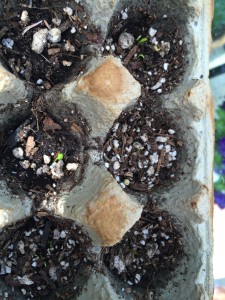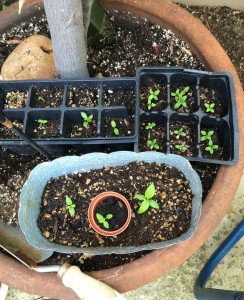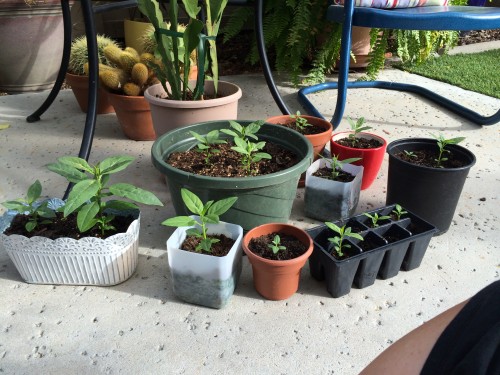Let’s recap my plight earlier this year — warm winter, tons of caterpillars, not enough Milkweed, too early in the season to buy plants at the nursery, starvation. And the plight of the Monarch population in general? In decline. Solution? More Milkweed.
My book club read Flight Behavior by Barbara Kingsolver the same month my first generation of 2014 caterpillars were growing. The story uses Monarchs as a metaphor for change and is filled with interesting Monarch information. Our book list, dates and locations are decided well in advance. Each of us selects a book for the list. Ironically I was not the one who selected the book. But I was the hostess and took full advantage of the opportunity. I ordered Milkweed seeds on the internet and sent everyone home with a pack. The order included more seeds than I could possibly distribute at one book club meeting so I’ve been handing out seed packets at every opportunity. But I confess, I didn’t really believe anyone would plant the seeds.
One of my oldest and dearest friends, who I’ll call MC and who also happens to have a green thumb, is growing Milkweed.
Now my definition of growing Milkweed is to tear open the packet of seeds, toss them on the ground, and hope for the best. I’m not a gardener, as you can tell. This method does work, but not effectively. The plants sprout in clumps and fight each other for resources unless you thin them out. Its survival of the fittest which ultimately produces fewer plants.
Another method for a lazy gardener such as myself is to buy and plant an already established Milkweed plant. It’ll flower and go to seed. Milkweed, as its name implies, is a weed. If it flowers and goes to seed you’ll multiply your supply with no extra effort. But be forewarned, the seeds have parachutes. Unless you collect and distribute the seeds you’ll find seedlings sprouting up in the most unexpected and annoying places. Eliminating them from areas such as the middle of your lawn also leaves fewer plants.
So back to my friend, MC. She received her packet of seeds at the book club meeting. Weeks went by and I thought nothing more of it. That is until my husband and I had dinner at her house and noticed the Milkweed factory on her back patio.
Growing plants from seed is a slow process. More weeks go by during which MC goes on vacation, but not without leaving instructions with her neighbor on how to care for the Milkweed seeds apparently. Then I get my first update, via text, and it includes a photo of the first seedling (see photo below) and we’re both quite excited. Several updates later and I’m thinking, I have to blog about this. Because how many butterfly enthusiasts like myself have dedicated growers. And honestly I’m touched that she is even doing this.
In the sweetness of friendship let there be laughter, and sharing of pleasures. For in the dew of little things the heart finds its morning and is refreshed. — Khalil Gibran
 MC is a citizen scientist and Monarch enthusiast in her own right. She experimented with several different growing methods, even citing Pinterest as one of her research sources. Some of the seeds she planted in an egg carton. The egg carton was left outside in partial sun and watered regularly to keep the soil most. This is the slow method of seed germination and alot like watching the grass grow apparently. The first seedlings took weeks to sprout.
MC is a citizen scientist and Monarch enthusiast in her own right. She experimented with several different growing methods, even citing Pinterest as one of her research sources. Some of the seeds she planted in an egg carton. The egg carton was left outside in partial sun and watered regularly to keep the soil most. This is the slow method of seed germination and alot like watching the grass grow apparently. The first seedlings took weeks to sprout.
MC also read about vernalization, the cooling of a seed during germination in order to accelerate flowering when it is planted. Yes, I had to look that one up on the internet. She placed seeds between sheets of moist paper towels in a plastic bag and then left the bag in her refrigerator. A few months later she planted the seeds in small pots and flats and several days later they sprouted. They are growing at a faster rate than the egg carton seeds.
Others say you should start seeds indoors or in a greenhouse. The need to do this probably depends on where you live and the pests you have in your area.
I attended a butterfly lecture recently and the lecturer described his process for expediting germination – vibrate the flat/egg carton by setting it on top of the clothes dryer. I looked this up on the internet too. It’s called scarification, a shaking that breaks the seed coat, which apparently some types of Milkweed require. It’s all too technical and time consuming for a lazy gardener such as myself and MC didn’t go quite that far in her experimentation since the Milkweed we’re growing, Mexican or Tropical Milkweed (genus Asclepias), doesn’t seem to require scarification.
Since the first sprout MC has lovingly cared for the baby seedlings, transplanting and thinning them out as they grow, preparing them for their future home which is my backyard. You see, I have alot of unexpected seedlings in my atrium right now (see parachute seeds above) and have run out of room. So I am expanding my Milkweed garden to my backyard.
MC came by this week to deliver the first few plants and this weekend I am planting them in the ground. But, being the serious gardener that she is, MC also came with a list of questions and to study my older Milkweed plants.
- Does Milkweed grow better in pots or the ground? I have Milkweed in both pots and in the ground, but when forced to look at the difference through MC’s eyes the answer is the ground.
- Do they like sun or shade? Sun, at the very least partial sun.
- Do they need alot of water? Milkweed are supposed to be drought-tolerant and I’ve heard several people say you shouldn’t overwater them. But I find in full sun in the middle of summer they need as much water as the rest of my plants. When the leaves start to wilt the plant needs water (and recovers quickly).
- What is their root structure? Tropical Milkweed has deep roots so if you’re planting in a pot get a deep enough pot.
I’m trying to talk MC into keeping a few plants herself so that she can enjoy her own butterfly nursery. It’s also good to have a partner or community. An attendee at this lecture I mentioned asked if anyone had extra Milkweed for her poor starving caterpillars. Apparently it’s not uncommon to bring Milkweed to the caterpillars or better yet bring caterpillars to the Milkweed.
So the other day another friend texts me out of the blue. “What are the yellow things on my Milkweed plant? Is that good?” I didn’t even know this friend had any Milkweed.
Who knows where the butterflies will lead me. But so far they have taught me not to underestimate my friends’ generosity, curiosity and/or love of nature and that it’s good to share your story. In fact, a more appropriate title for this blog post would’ve beeen “Friendship”.
Anyway, there are many resources on the internet for growing Milkweed. Keep in mind that I’m growing Mexican/Tropical Milkweed and that the information may vary by type of Milkweed. Plus taking the advice of a lazy gardener is probably not wise. So here are some sites that I have found helpful if you’re thinking of growing your own Milkweed: Monarch Watch, University of Minnesota Monarch Lab, Live Monarch, Stewardship Garden to name a few. But if you do grow Milkweed the most important thing to know is this — you’re growing Milkweed as food. Do not treat your plants with pesticides, herbicides and any other “cides”.



Post your comment